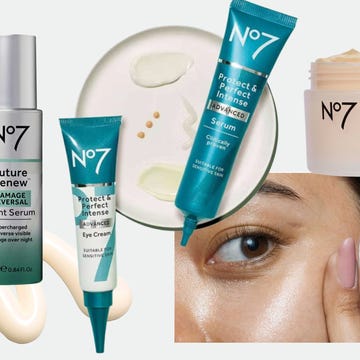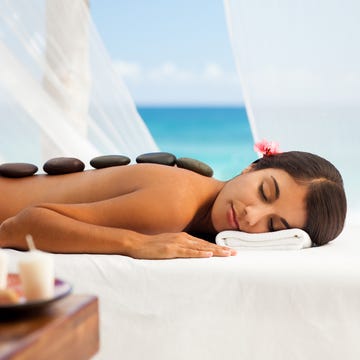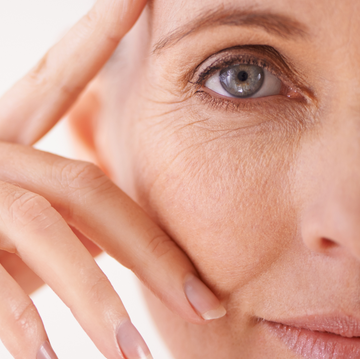We earn a commission for products purchased through some links in this article.
All the best body SPFs for all skin types, with no white cast or greasy feel
Plus your expert guide on how to stay safe in the sun

Temperatures are soaring but unfortunately so, too, are skin cancer rates. It’s now the most common cancer in the UK, with at least 100,000 new cases diagnosed each year, according to the British Skin Foundation. However, that doesn’t mean you can’t enjoy the sun – you just need to respect it, stick to sensible limits in terms of exposure and protect your skin from UV damage.
‘We definitely want people to enjoy the sunshine,’ says consultant medical oncologist Dr Fiona McCarthy. ‘Being outside in the sun is great for your general wellbeing but just remember to do it safely. By that I mean ideally applying an SFP30-50 with both UVA and UVB protection and topping it up regularly.’
The latest SPFs are making that task a whole lot easier. While higher SPFs traditionally meant thick textures and white residue on skin, modern sunscreen formulas are easily absorbed, don’t leave a visible white tint and are pleasant to apply.
In short, it’s never been easier to enjoy your summer safely. We’ve picked the latest and best body SPFs to try (you’ll also find our recommended facial SPFs here) and we’ve also put together an expert guide on how to protect yourself both at home and on holiday.
Can I tan safely if I don’t burn?
In a word, no. ‘Any kind of tan indicates some kind of damage to your cells,’ says Dr McCarthy. ‘Even if you’re not burning, the change in colour means your body has produced more melanin to try to protect you from the damage that’s happening. There’s simply no way of getting a safe tan.’
How much sunscreen do I need to wear on holiday?
Plenty, if you want to get the protection level on the bottle. ‘For your face and neck, it’s three stripes the length of your middle three fingers and a full 30ml shot glass for the rest of your body,’ says consultant dermatologist and Heliocare ambassador Dr Emma Wedgeworth. The same goes for sunbathing at home as well as abroad.
You’ll need to allow plenty of time for your SPF to rub in and then repeat the whole process every two hours – SPF rubs and sweats off and its protection eventually breaks down under UV rays. Dr Wedgeworth advises combining SPF with sun hats and UV-protectant clothing, seeking shade where possible and avoiding direct sun between 11am and 3pm.
How low can I go with SPF?
Honestly? Not very. To reduce skin cancer risk, ‘you should be protecting yourself with SPF30-50 every day in direct sunlight,’ says Dr McCarthy. The SPF number shows how much longer you can stay in the sun without burning versus not wearing sun protection – for instance, if you normally burn after five minutes, SPF30 extends that to 150 minutes IF you’ve applied it properly. ‘We know the reality is that people under-apply their SPF and forget to reapply regularly so won’t get the full protection level stated on the bottle. So it makes sense to go for a higher number.’
I have darker skin, do I need SPF?
Yes, says Dr McCarthy. ‘The increased melanin in your skin does confer some natural protection but not enough to guard fully against UV damage. Although skin cancers are less common in skin of colour, they do occur and are often picked up later and so have worse clinical outcomes.’ Preventing UV damage in the first place is vital.
Can I reduce my SPF during my holiday?
No, you absolutely should not reduce your SPF as your skin ‘acclimates’ – that’s a myth,’ says Dr McCarthy.
I have sensitive skin, should I use a mineral sunscreens?
Mineral sunscreens contain ingredients such as zinc oxide and titanium dioxide to absorb but also deflect UVA/UVB, while ‘chemical’ sunscreens absorb and help neutralise the UV rays. ‘Mineral SPFs are often recommended for more sensitive skin because the physical barrier ensures there is less of a chance of irritating already-sensitive skin,’ says Dr McCarthy. The best modern mineral sunscreens also absorb invisibly, unlike the chalky products of yesteryear.
Don’t dismiss non-mineral formulas, though. As Dr Wedgeworth notes: ‘There are now many good, gentle chemical filters, which means mineral and chemical sunscreens can be equally non-irritating.’ In other words, SPFs of both types have come a long way, so use whatever suits you!
Do I need a separate SPF for my face and body?
Technically, no, says Dr McCarthy. ‘The main reason for different SPFs for the face is that the facial SPF formulas are often lighter and so more pleasant to use, particularly under makeup.’ But if it suits your skin, there’s no reason you can’t apply one SPF all over.
Do body SPF mists work?
They’re quick, easy and convenient but ‘they need to rubbed in to work effectively,’ says Dr Wedgeworth. She adds that you also need to ‘spray on plenty’ in the first place.
Can I go straight in the sun after applying SPF?
Wait after applying a regular chemical sunscreen before going in the sun, says Dr McCarthy. ‘It takes about 15 minutes for the skin to absorb the sun cream – go out sooner and you won’t get the level of protection on the bottle. However with mineral SPFs, you can go into the sun immediately.’
Will wearing SPF leave me deficient in vitamin D?
This is a question Dr McCarthy hears all the time and the answer is a firm no. ‘Vitamin D is essential for bone health and general wellbeing and its active form is produced by the interaction of UVB rays with the skin,’ says Dr McCarthy. ‘However, several clinical studies have shown that daily sunscreen use doesn’t lead to vitamin D insufficiency. People who use sunscreen daily can maintain their vitamin D levels.’


Oti Mabuse on beauty and body positivity as a mum

Downton’s Joanne Froggatt has ‘mind-blowing’ skin

Shirley Ballas has no-knife facelift for Strictly

These are 10 of the best No7 skincare products

























